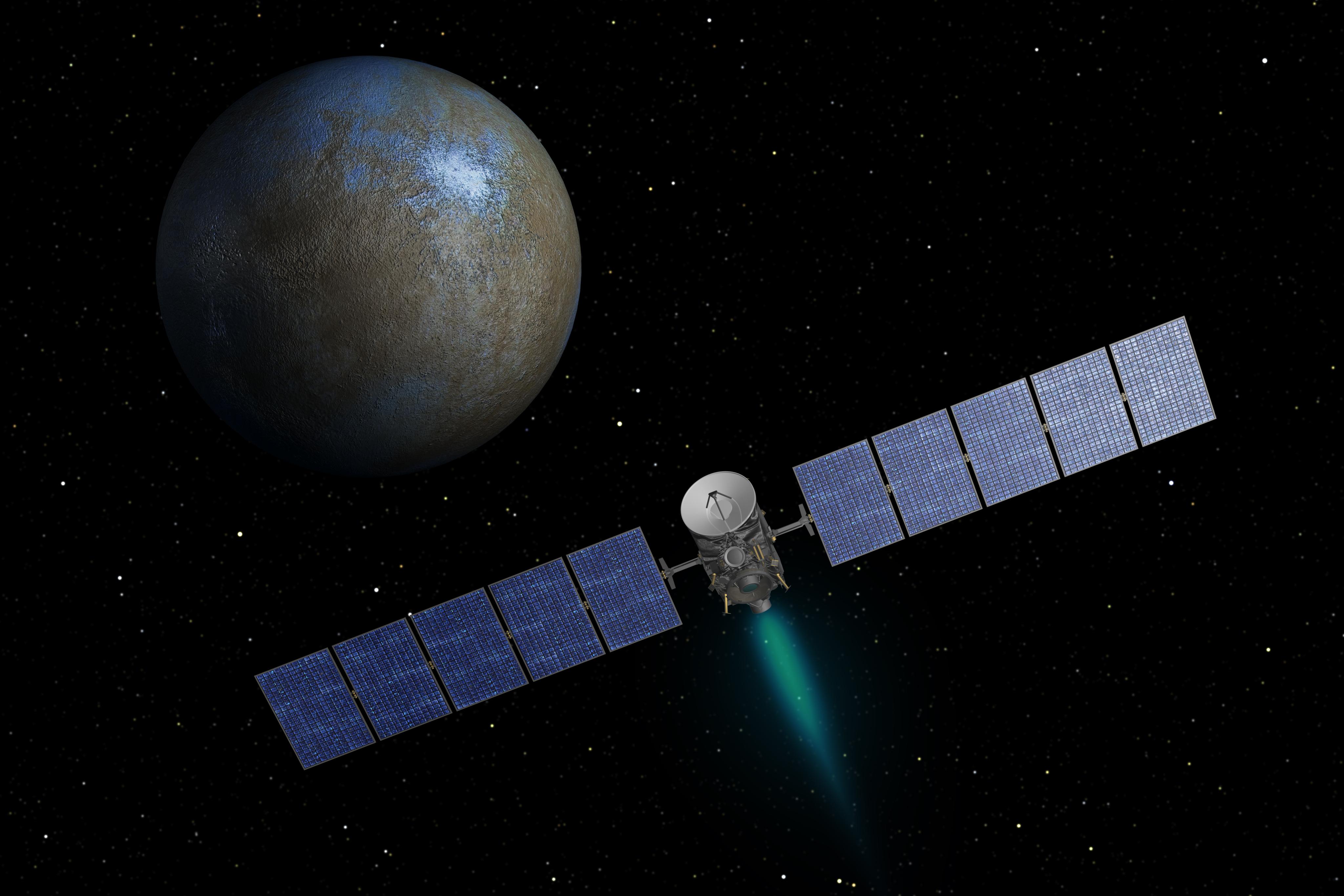
NASA's Dawn spacecraft will begin orbiting the mysterious dwarf planet Ceres this week, ending a deep-space chase that lasted 2 1/2 years.
Dawn is scheduled to reach Ceres — the largest body in the main asteroid belt between Mars and Jupiter — on Thursday night (March 5). The probe has been headed for Ceres since September 2012, when it departed Vesta, the asteroid belt's second-biggest denizen.
Dawn's Ceres arrival should be a relatively low-key affair, as far as big spaceflight moments go; the probe employs superefficient, low-thrust ion engines and is approaching the dwarf planet quite slowly. [Amazing Photos of Dwarf Planet Ceres]
"We've been using the ion propulsion system for a long time gradually to reshape Dawn's orbit around the sun so that it matches Ceres' orbit," said Dawn Mission Director and Chief Engineer Marc Rayman, who's based at NASA's Jet Propulsion Laboratory in Pasadena, California.
The principle involves "letting the spacecraft creep up on Ceres so that it gets close enough, and is traveling slowly enough relative to Ceres, that Ceres' gravity can gently take hold of it," Rayman told Space.com in late January.
There will thus be no nail-biting, make-or-break engine burns on Thursday night.
The $466 million Dawn mission launched in September 2007 to study Vesta and Ceres, which are 330 miles (530 kilometers) and 590 miles (950 km) wide, respectively. Dawn's observations of these planetary building blocks should shed light on the planet-formation process and the conditions prevalent during the solar system's early days, NASA officials have said.
Get the Space.com Newsletter
Breaking space news, the latest updates on rocket launches, skywatching events and more!
Dawn orbited Vesta from July 2011 through September 2012. If all goes according to plan, on Thursday night, the probe will become the first spacecraft ever to orbit two celestial objects beyond the Earth-moon system.
Dawn will then spend about six weeks spiraling down to its first science orbit, which the probe will reach on April 23. Observations of Ceres will begin in earnest at that point and continue through June 30, 2016, when the mission is slated to end.
Ceres is a little-known object that Italian astronomer Giuseppe Piazzi discovered in 1801. It's the only dwarf planet in the asteroid belt, and it contains about 30 percent of the belt's total mass.
Ceres is thought to possess a great deal of water, mostly in the form of subsurface ice. Some scientists think the dwarf planet may even harbor lakes or oceans of liquid water beneath its surface, raising the possibility that Ceres might be capable of supporting life as we know it.
Dawn is not equipped to search for signs of life. But the probe will give researchers their first up-close looks at Ceres, bringing the intriguing world into much clearer focus.
That's already happening, in fact: Recent Dawn photos have revealed new information about Ceres' mysterious bright spots, which mission team members plan to investigate further from orbit.
"We already knew from the Hubble Space Telescope that there were bright regions on Ceres. However, those images of the bright spots, taken more than 180 million miles away, appear to be large," Dawn principal investigator Chris Russell of UCLA said in a statement Friday (Feb. 27).
"As Dawn has come closer to Ceres, the bright spots have become brighter and smaller. Indeed, they are much brighter than the surrounding landscape and still unresolved in our images," Russell added. "The point of origin must be very small."
The bright spots are thus apparently produced by a phenomenon that works on a much smaller scale than that of Ceres' many craters.
"And since I don't have a clue what this is, I am puzzled," Russell said.
Follow Mike Wall on Twitter @michaeldwall and Google+. Follow us @Spacedotcom, Facebook or Google+. Originally published on Space.com.
Join our Space Forums to keep talking space on the latest missions, night sky and more! And if you have a news tip, correction or comment, let us know at: community@space.com.

Michael Wall is a Senior Space Writer with Space.com and joined the team in 2010. He primarily covers exoplanets, spaceflight and military space, but has been known to dabble in the space art beat. His book about the search for alien life, "Out There," was published on Nov. 13, 2018. Before becoming a science writer, Michael worked as a herpetologist and wildlife biologist. He has a Ph.D. in evolutionary biology from the University of Sydney, Australia, a bachelor's degree from the University of Arizona, and a graduate certificate in science writing from the University of California, Santa Cruz. To find out what his latest project is, you can follow Michael on Twitter.
